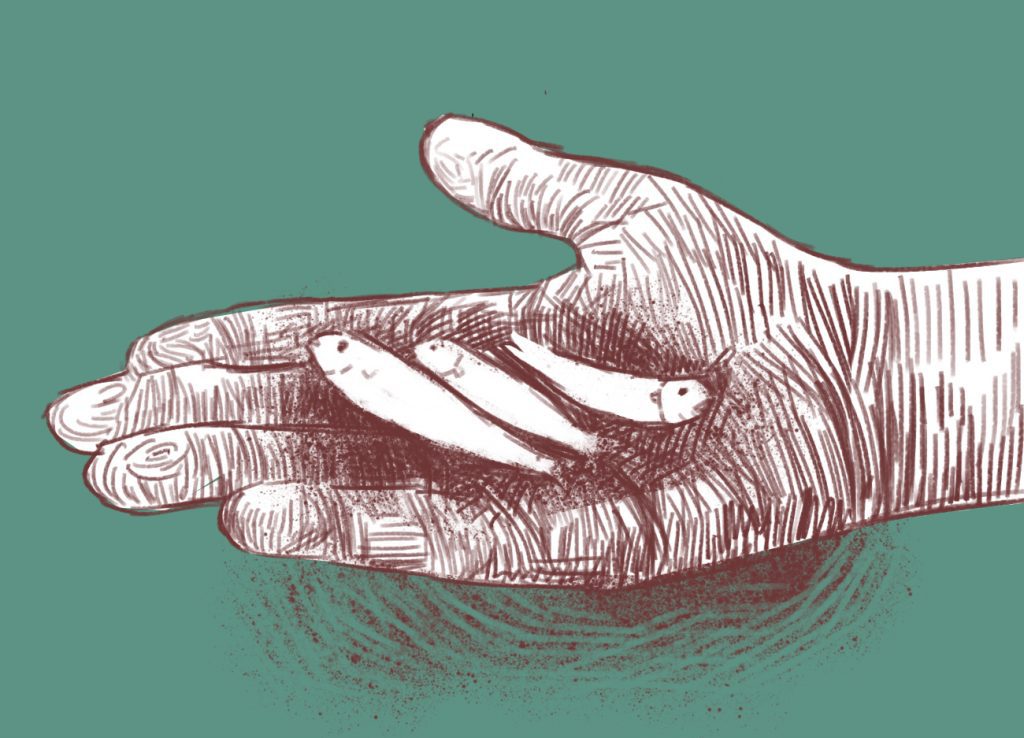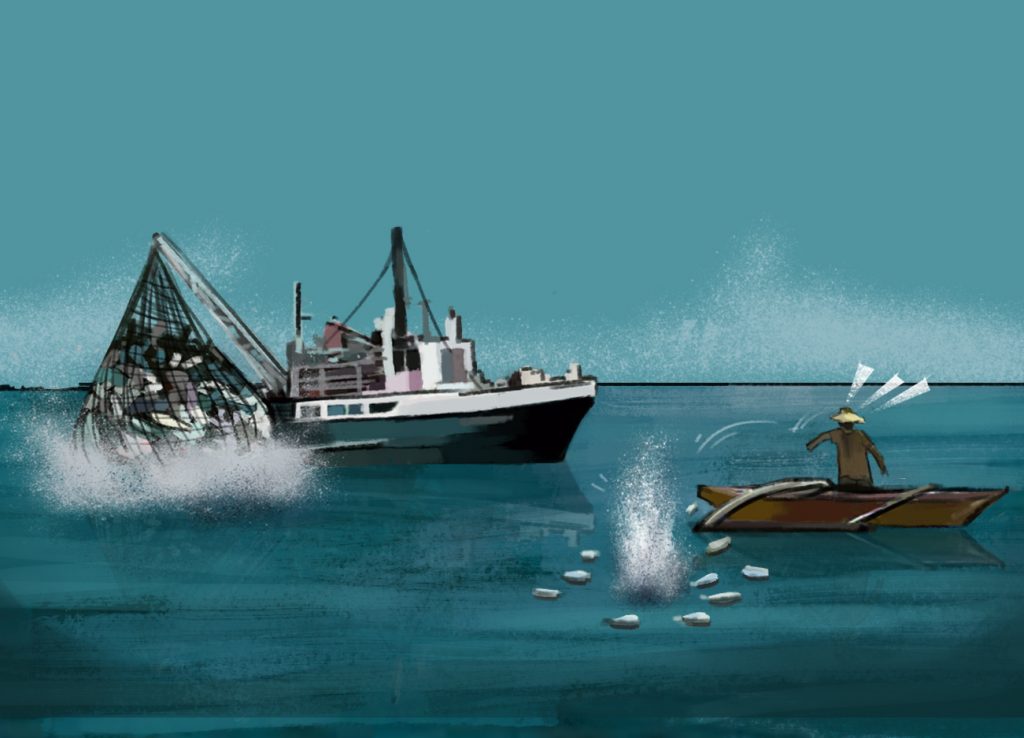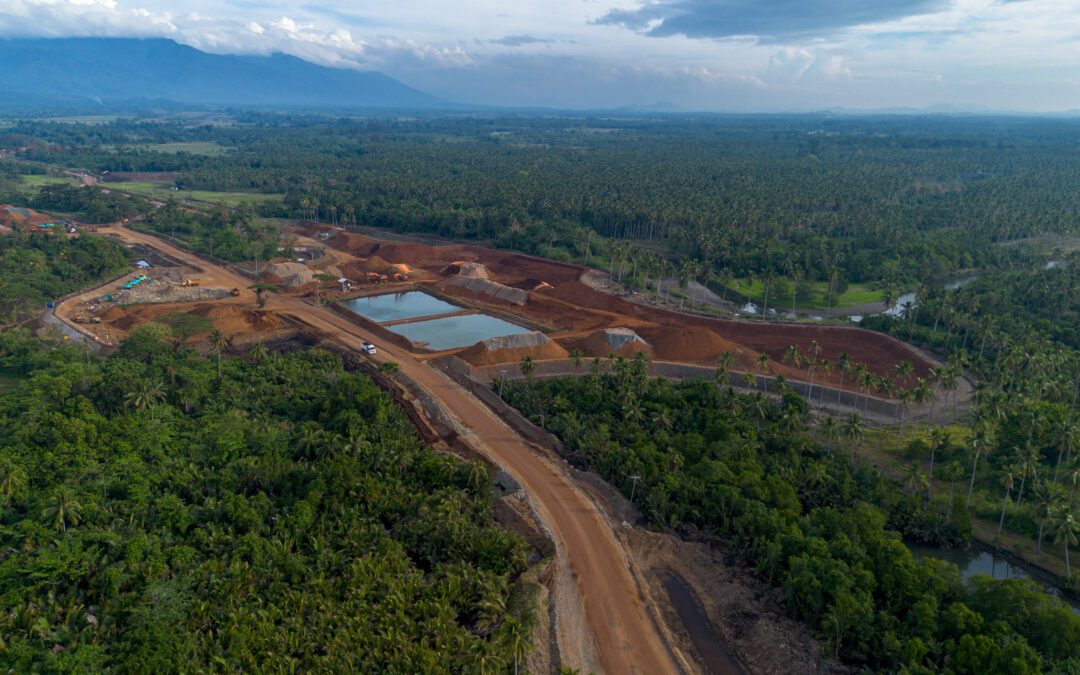Community fishermen are typically poor and buried in debt as they lose out to dynamite fishing as well as commercial fishing boats intruding into municipal waters. A proposed law will exacerbate their woes.
By Leilani Chavez/PCIJ

Ruel*, an artisanal fisherman from Bantayan Island in Cebu province, always preferred to fish at night. He set out to the Visayan Sea at 5 p.m. and returned around 9 p.m. There’s always a better catch, he said.
When the coronavirus pandemic forced the entire country into lockdown in March 2020, fishing at night was no longer an option, however. A curfew was set on the island from 9 p.m. to 5 a.m. daily.
“We can’t fish at night because it’s too risky,” Ruel said. The threat of getting apprehended would further destabilize his precarious finances. Around the country, thousands were jailed for violating lockdowns and in Ruel’s town, the fine was P50. While minimal, it’s enough to buy a kilo of rice.
Those days Ruel sneaked out to sea at 3 a.m. instead. He still violated the curfew, but he figured the mornings were safer because he would return to shore at 8 a.m.
He also had to fish alone rather than join the usual pack — to avoid contracting Covid-19 and the attention of patrolling cops and village watchmen. It meant he had to shoulder the cost of gasoline for the boat by himself.
“The lockdown period was tough,” Ruel said. “Although my children stopped going to school, we incurred additional expenses for vitamins and soap. With this virus we can’t skip washing our hands.”
After two months of lockdown, the government finally recognized artisanal fisherfolk as “essential personnel” and allowed them access to the sea at any time of the day. By then the monsoon had arrived and the risk of accidents for the small boats of artisanal fishermen like Ruel was high. The inclement weather also drove away fish stocks.
Ruel is one of 900,000 artisanal fishermen in the Philippine archipelago, the fifth largest island nation in the world whose territorial waters cover 679,800 square kilometers or about six times the land area of Luzon island. The country’s exclusive economic zone – surrounding the country’s more than 7,600 islands – stretches for another 2.2 million square kilometers.
Artisanal fishermen — those who use fishing boats weighing less than 3.1 gross tons — are among the country’s marginalized. They typically live below the poverty line, have five to 13 children while supporting an extended family, and are buried in debt, based on community assessments by Rare Philippines, a marine conservation NGO.
“On a positive note, the Covid-19 pandemic has taught the general public to appreciate our farmers and fisherfolk and realize the value of the whole food sector as a pillar of our nation,” said Eduardo Gongona, a retired coast guard commodore who is now the director of the Bureau of Fisheries and Aquatic Resources (BFAR), an agency under the Department of Agriculture (DA).
But the government’s action on the plight of fisherfolks, many of whom were unable to bring food on the table when lockdowns prevented them from going out to sea, barely scratched the surface of a tangled problem brought on by decades of neglect.
Poor catch
Bigger problems persisted even before the advent of Covid-19. Fisherfolks complained of catching less and communities talked of days when the seas deprived them of bounty.
Fisheries figures from the Philippine Statistics Authority (PSA) showed that the volume of marine fish catches both by commercial and artisanal vessels have been on a steady downward trend in the last 10 years — peaking in 2010 at 2.4 million metric tons and reaching a low 1.9 million metric tons in 2020.
These numbers may not be the best indicators because huge volumes are not reported due to the prevalence of illegal fishing in the country, but there’s rich anecdotal evidence of this decline.
Fisheries experts estimate that artisanal fisherfolk around the country catch five kilos a day on average, a far cry from the 50 kilos a day in the 1970s and 1980s. Assessments of coastal communities also showed that the species being caught had shifted due to diminishing stocks.
“Artisanal fishers can’t catch lapu-lapu (grouper) and maya-maya (snapper) anymore,” said Julius Guirjen, a Mindanao-based program officer of Rare Philippines, referring to high-value fish that fisherfolk used to focus on.
“Instead, they catch pufferfish and clownfish. These are species they didn’t eat before… They don’t even give it any attention before because there were more expensive fish around. But they do now… basta may maiuwi at may makain lang (as long as they can bring home something and have something to eat).”
The poor catch is a result of decades of abuse that resulted in the decline of the country's marine resources. Various academic studies and assessments by groups like the USAID estimate that 70% of the country’s waters and major fishing grounds are overfished.
This decline has also led to an overhaul of the country’s policies aimed at preventing the collapse of marine resources, which imposed restrictions that further contributed to fishermen’s poor catch.
With the passage of the Fisheries Code of 1998, the country began to ban particular fishing gears — the use of explosives and poisonous substances like sodium cyanide, muro-ami (a pounding device for reef fishing), and the use of fine mesh nets and superlights among others — which boosted fish catch but were destructive of marine habitats.
It also banned the use of active gears such as trawling, purse and Danish seine techniques, as well as gill nets, air compressors (paaling) and tuna longlines within municipal waters.
Guirjen said drastic efforts were necessary to limit the strain on the country’s overworked seascapes.
In the Visayan Sea — a rich source of sardines and a variety of high-value species such as tuna, mackerel and blue swimming crabs — fishermen have seen declining catch. It is closed annually from November to March to allow the fish to spawn. The nearby Pasil town, where Cebu’s oldest fish market is located, had to open trading with Mindanao to meet the needs of the province’s growing population, particularly of Cebu City.
Dodong, a fisherman of Madridejos town, said they could haul up to 20 kilos after a three-day excursion to the Visayan Sea if they were lucky. He takes the fish to trading centers and haggles with consigners or tarima, wholesalers or brokers, in a process called bulungan, where prices are set through whispers. If he catches less, his wife takes it straight to the market to sell at current prices.
On a successful fishing day, Dodong earns between P400 to P1,000. A five-hour trip will consume five to 10 liters of crude oil, costing around P300 to P600 at current rates. He spends what’s left of his money to buy food and try to save a few pesos for days that he calls “zero” – when nets are empty.
“I save up because there are days when I can’t catch anything so you go out again, spend again… you need to have money saved up for that,” he said.
The government provided financial support through the Social Amelioration Program (SAP) and two of the five fishermen interviewed by the Philippine Center for Investigative Journalism (PCIJ) from the three towns in Bantayan Island twice received P8,000 to P10,000. Two others received one lump-sum payment of P5,000, while another fisherfolk said he didn’t receive any cash support and instead depended on rice assistance from the local government office.
“The amount helped a lot but it’s not enough to raise a family of five,” Dodong said. “It’s good the local government gave us rice… at least we only have to worry about what to eat with it. If we’re hungry... well, that’s why we planted cassava.”
Illegal fishing
Under Republic Act 8550 or the Philippine Fisheries Code of 1998, amended in 2013 by Republic Act 10654 or the Amended Fisheries Act, only artisanal fishermen are allowed to fish inside the country’s municipal waters or 15 kilometers from the coastline.
It was intended to protect shallow waters, the spawning areas of marine organisms (mangroves, seagrass beds and coral reefs), said Diovanie de Jesus, a marine scientist from Oceana Philippines, a conservation NGO. “It’s an important habitat for small fish like sardines, a species which spawns within municipal waters. If we protect the municipal waters, we are in turn, making sure there’s sustainability in the productivity of the oceans,” he said.
The law was passed in the wake of the European Union (EU) slapping a Yellow Card fisheries rating on the Philippines in June 2014, warning that unless the country took drastic steps to address illegal, unreported and unregulated fishing, all Philippine seafood would be blacklisted in member countries of the EU, the world’s biggest fish importer. With the tag, the Philippines risked losing seafood imports that in 2013 was valued at P9.4 billion.
The ban on commercial fishing in municipal waters was supposed to protect the livelihood of artisanal fishermen, who cannot compete with the bigger boats. However, illegal fishing by fellow artisanal fishermen and commercial fishermen alike continued to be a problem.
There are four common types of illegal fishing in the Philippines, according to BFAR. They are dynamite fishing, cyanide fishing, the use of modified Danish seine or known locally as hulbot-hulbot, liba-liba and, in Bantayan, as zipper, and the intrusion of commercial vessels within municipal waters.

A recent report from the DA-BFAR and the USAID Fish Rights estimate that municipalities lose 257,000-402,000 metric tons per year to illegal fishing. The value ranges from P24.1 to P37.8 billion.
Illegal fishing is a problem that continues to challenge authorities. Experts interviewed by the PCIJ said patrolling the vast marine territory remains a formidable task for the fisheries agency and various enforcement units burdened with resource limitations, management bottlenecks, and irregularities in the implementation of “game-changer” policies.
Dynamite fishers are difficult to apprehend as violators construct the makeshift bombs in the middle of the sea while pretending to do collective fishing, said Wilmon Peñalosa, a lawyer and officer with Negros Occidental’s lauded Task Force Lawod, whose operations saw a 90% decline in illegal fishing activities since it began in 2014. Constructing the dynamites at sea leaves little evidence for enforcement officials on land, he said, because illegal fishers or “iligalista” dispose of the evidence immediately after.
Once fish stocks reach trading sites, illegally caught fish seep freely into the legal trade, in part due to the lack of seaborne inspections or maneuvering by boat operators to block scrutiny.
Annual fisheries statistics released by the PSA based on surveys covering 282 commercial fisheries landing sites, 840 municipal fish landing centers and 1,261 fishing households make no distinction between legal and illegal fish. It is safe to assume that fisheries statistics cover both illegal and legal fish, pointing to the ease of legalizing fruits of the illegal trade, a global fisheries expert said.
In the communities, fish caught with dynamite are washed, cut and gutted as quickly as possible, fisherfolk narrated in an interview. Blast fishing turns fish within the immediate vicinity of a blast to shattered flesh and bones, but the ones further from the explosion radius are bloodied, easy to clean and leave little traces that won’t be detected by an untrained eye.
“Dynamite fishers wash the fish but if you open it, the insides are all mangled,” said Jun, a fisherman who manages a marine park. “Consumers won’t be able to tell the difference because it’s common to ask sellers to gut and clean it. But if you put blasted fish beside netted fish, the difference is glaring.”
Despite the ban, local fisherfolk we interviewed said dynamite fishing proliferated last year, instigated by fishers aboard pump boats from neighboring Panay Island. Antonio, a crabber, said the seas are “erupting as if there were underwater volcanoes” more frequently compared with 2019.
The unencumbered entry of illegal fish in the market has for decades been linked to limitations in monitoring, knowledge and training gap, and the secrecy of the trading system itself. Fisherfolk, however, pointed to the likelihood of money changing hands.
The uncertainty of the pandemic made prices attractive: A kilo of legally caught agumaa anduhaw, chub mackerel popular in Cebu, was sold for P180 during the pandemic. Meanwhile, dynamite fishers sold the same fish for half the price. It’s a quick transaction: by the time monitoring officers did their inspections, the blasted fish had been bought and taken home by unsuspecting consumers.
“If you’re in the fishing industry, you know which fish are illegally caught or not,” said Jun. “Consigners know if fish are caught with dynamite but they keep quiet because it’s cheap fish they could sell at market rates. The guards in fish ports know too. They overlook it because it’s common and they probably accept bribes—how else could those fish freely enter the market?”
Commercial fishermen
Artisanal fisherfolk aren’t the only ones breaking the rules: Satellite images and on the ground observation by communities, officials and experts point to the increasing incursion of small and medium-scale commercial vessels inside municipal waters.
Island towns like Bantayan have been particularly vulnerable, experts said, because commercial fishing groups contest that small islands are entitled to their own municipal waters.
Four fisherfolk in the central Philippines we interviewed in separate calls attest to the proliferation of commercial vessels within their territories. They recalled sharing municipal waters with at least five commercial fishing vessels that use the zipper, Cebu’s term for hulbot-hulbot, a modified Danish seine trawling technique. The DA-BFAR introduced the Danish seine in the 1980s but locals added heavy stones, leading the fisheries agency to ban the method by 2000 because of the massive destruction it brought to seabeds and coral reefs.
Zippers are notorious for “emptying an area” of fish. Vessels that fished too close to shore dragged away wooden traps that fisherfolk had set nearshore to trap blue swimming crabs.
Local mayors said that when a commercial vessel passed by, it meant “days of no fish catch for community fisherfolk.”
A medium-scale commercial vessel weighing more than 20 gross tons, the same ones used to ferry vehicles, cargo, and passengers across the islands in the Visayas, could fill 20,000 banyera, a fish tub weighing 40 kilos. This would allow a ship to catch 800,000 kilograms of fish a day.
With five vessels in one area, the collective catch would be equivalent to 4 million kilograms or 4,000 metric tons.
The numbers seem exaggerated, but they aren’t, Ruel insisted. In his 20s, he joined a zipper crew and earned P8,000 a month. “The owner of our vessel earned P12 million in just one night of fishing. Expenses for crude oil cost only about P200,000 to P300,000, so you can imagine how much he earned—and for one night! I couldn’t believe it…I barely earn P500 a day when I fish with my boat,” he narrated.
The volume and value of the fish were recorded in the ship’s logbooks, Ruel said. Fisheries law requires vessels to record fish catch, which are presented to the BFAR when renewing permits.
He doubted, however, if the real figures were reported to the government. Now in his mid-30s, Ruel has returned to being an artisanal fisher and vowed to never join a commercial vessel again.
“The income is stable but it makes me feel guilty,” he said. “If all the fishermen in my community combined the fish we caught in a week, the collective volume would only be 200 to 400 kilos – that’s the difference between what commercial vessels are catching from what we get from the seas.”
Data from Karagatan Patrol, a platform managed by conservation NGO Oceana Philippines that utilizes the Visible Infrared Imaging Radiometer Suite (VIIRS) technology, helps in understanding the extent of the problem. It detected 40,204 boats from January to November 2020 – the largest number of vessels detected by the technology since it was adopted in the Philippines in 2013.
While the VIIRS was groundbreaking, it has limitations: it only captures superlights at night and could cluster a group of lure lights used by artisanal fisherfolk as one commercial vessel. The technology couldn’t keep tabs on activities of trawler vessels like hulbot-hulbot since these ships don’t use lure lights and dynamite fishing activities are out of the purview of the technology, experts said. As such, enforcement units need to verify the data by conducting seaborne patrols following leads from coastal communities.
Still, the technology has been helpful to enforcers, said Gloria Estenzo Ramos of Oceana Philippines. “Because there’s real-time sharing of data on Karagatan Patrol, they were able to catch and enforce the law especially during the pandemic,” she said.
Boat operators have found ways to prevent enforcers from boarding, concealing and destroying gears before docking, conducting transshipment activities at sea, and taking advantage of the inherent gaps in inspections conducted in landing and trading centers.
The inconsistency in the implementation of fisheries policies across towns, municipalities and cities in the country has likewise exacerbated the problem.
In Madridejos town, one of the three towns in Bantayan and among the municipalities in the country with high incidences of illegal fishing, hulbot-hulbot is “semi-legal.”
“Commercial vessels more or less use zipper or hulbot-hulbot here,” a source said, adding that commercial vessels docked in Madridejos have encroached on the seascapes of its neighboring towns in the island. It may not be banned in the province or on the island as it’s part of an “election campaign promise.”
Similarly, artisanal fisherfolk lack understanding of the law and the gravity of their offenses, said Col. Oliver Tanseco of the Philippine National Police-Maritime Group (PNP-MG). As such, they are taken advantage of by commercial vessel operators.
“Commercial fishing boat operators exploit fisherfolk’s financial weakness and those who have no means of income are forced to return to illegal practices. Most of them aren’t even aware that they could get imprisoned,” he said.
The dangers of a proposed law
The amended Fisheries Code mandated the installation of tracking systems – vessel monitoring mechanism (VMM) and electronic reporting systems (ERS) – on all commercial vessels. Eight years since, only 643 commercial vessels have installed transponders as of July 9, 2021, far from the 4,876 target set by BFAR under its Integrated Marine Environment Monitoring Systems (IMEMS) project.
Initially, the BFAR required it only on large-scale commercial vessels that operate along territorial borders, exclusive economic zones and designated global seascapes under fishing access agreements. Oceana Philippines challenged this and filed in 2018 a petition with the Supreme Court to include small and medium-sized ships in the tracking system.
“Many of these vessels are violators of the illegal fishing ban,” Ramos said.
CAPTION: Red dots show the location of possible commercial vessels within municipal waters, shown here as blue borders, from March to May 2020. Source: Karagatan Patrol
When the BFAR finally consented through an administrative order in October 2020, Cebu Rep. Pablo John Garcia filed House Bill 7853 in the same month. Under the bill, commercial vessels will be given sweeping access to municipal seascapes, a proposition various groups, communities and artisanal fisherfolk are blocking this early with signature campaigns, manifesto and local ordinances.
“Obviously, they don’t want to be covered by the VMM. They don’t want to be transparent because the technology will show agencies and enforcement units exactly where they are,” Ramos said, adding that commercial operators have filed a petition with the Supreme Court to exempt proponents from installing the tracking devices before the lapse of the one-year roll-out period.
The fishing industry, which navigates a highly bureaucratic sector and economically favors ship owners or brokers, gave rise to an affluent class of fish traders who “could directly influence election outcomes” and “hold sway over government regulations,” according to Romeo Jumao-as Toring, a researcher with the Visayas State University.
As such, some domestic commercial operators, particularly the large ones, “live under a system of impunity,” said Danny Ocampo, illegal fishing program head of Oceana Philippines. “During consultations conducted in Cebu, Zamboanga City, Bataan—major fishing areas—some commercial vessels were very brazen. They said: “We admit fishing within municipal waters. Go ahead, arrest us. We go there because that’s where the fish are.”
“Because of the weak enforcement, lack of localized science studies and, I guess, communication on the part of the government, they are emboldened,” Ramos added. “They developed a sense of entitlement. With VMM, hopefully, we’ll get more transparency and this impunity will cease.”
Not all commercial operators, however, resist the tracking system. Some groups, like the Subic Fishing Association, comply with the law and avoid fishing within municipal waters, Ocampo said. “But what they always say is that there should be incentives for them,” Ocampo said.
“They ask that the government do the appropriate action to ensure that they could continue fishing in the West Philippine Sea, which has been heavily impacted by the intrusion of foreign vessels.”
President Rodrigo Duterte, however, has given China free rein over fish stocks in the West Philippine Sea. In the Philippines’s eastern seaboard, in the Pacific region, the 48 Philippine commercial vessels licensed to operate there have been eclipsed by the 290 Chinese fishing fleets subsidized by the Chinese government.
Holistic approach
Experts and officials said it’s not enough to address the poor implementation of fisheries laws.
“For the longest time, when we talk about illegal, unreported and unregulated fishing, it’s a blame game. National passes the responsibility to local governments, local governments say they lack the resources. The next best thing to do is to understand what drives the fishers to commit illegal fishing and what compels them to follow the rules,” said Peñalosa.
Rare Philippines’s Dennis Calvan said a common problem was the “misprioritization” of public funds, investing it away from fisherfolk communities.
“Most local government units, when they have an increase in revenue or they get increased resources, most of the time they will use that resource investing in infrastructure,” Calvan said.
Few local governments invest in the conservation of marine resources like mangrove reforestation, providing incentives for Bantay Dagat or community guards, and even in establishing community trading markets to benefit fisherfolk. Few local governments have supported fisherfolk by providing new nets and not all local governments have Coastal Management and Fisheries Offices to begin with.
“If you look at coastal cities or municipalities, even though the majority of the constituents are fishers, the government invests heavily on infrastructure because it’s a visible sign of progress,” Calvan said.
“The prioritization will depend on the level of appreciation of the leadership,” Calvan said. “Officials need to understand that they should provide allocations for the Coastal Resource Management Offices… as a matter of fact, they should help establish and support these offices.”
There is a need to go for a “holistic approach,” said Peñalosa. It should address the nuances of poverty and the system that keeps it in place, as much of the battle against illegal fish trade isn’t in the seas but on land. –PCIJ






0 Comments